Cactus Air Force
F4F-4 Wildcat and P-400/P-39D Airacobra
over Guadalcanal

Arma Hobby, 1/72 scale
S
u m m a r y : |
Description and Item No.: |
Arma Hobby Kit No. 70049 - Cactus Air Force: F4F-4 Wildcat P-400 / P-39D Airacobra |
Contents and Media: |
Unique Parts - 15 parts in 3D printed grey resin; eight new marking options; tray-style robust box (hooray!)
P-400 Airacobra - 83 parts in grey plastic; five parts in clear plastic; three small chrome balls; yellow Kabuki die-cut self-adhesive paper masks.
F4F-4 Wildcat - 80 parts in grey plastic; five parts in clear plastic; self-adhesive canopy and wheel masks. |
Price: |
€56.36 plus shipping available online at Arma Hobby
£64.60 UK Price (£53.83 Export Price) Plus Shipping at Hannants
and hobby retailers worldwide |
Scale: |
1/72 |
Review Type: |
First Look |
Advantages: |
High quality moulding; gorgeous surface textures and detail; many useful options; high quality decals; highly detailed 3D printed upgrade parts for both models; tray-style robust cardboard box. |
Disadvantages: |
None noted. |
Recommendation: |
Arma Hobby's 1/72 scale P-39 Airacobra and F4F-4 Wildcat are both a gorgeous kits with crisp surface textures, high moulding quality, thoughtful parts breakdown, useful options and very high level of detail. Having both kits together in the one box can only be a good thing! |
Reviewed by Brett Green

Background
"Cactus" was the code name for the US air base on Guadalcanal, an island that faced heavy fights in the second half of 1942. The combined forces of the US Marine Corps, US Navy and USAAF stopped the onslaught of a Japanese invasion for the first time in the war. This would not have been done without a combined air force called the Cactus Air Force. This informal unit operated from the summer of 1942 to the spring of 1943, when its structure was reorganised as part of the 13th Air Force.
The Marines landed on the island on August 7, 1942. The first US aircraft over Guadalcanal came from the aircraft carriers USS Saratoga and USS Enterprise. They repulsed two waves of G4M Betty bombers escorted by Zeros, inflicting heavy losses on them. The Americans quickly finished the runway and named the base Henderson Field (a USMC officer killed in the Battle of Midway). On August 20, the first Marine aeroplanes were landed there, SBD bombers from VMSB-232 and F4F-4 Wildcat fighters from VMF-223, delivered by the aircraft carrier USS Long Island. P-400 Airacobras from the 67th USAAF Squadron joined them two days later..
Japanese tactics were based on massive air raids, land attacks and shelling from the sea. Cactus Air Force pilots repulsed air raids, supported infantry operations by bombing Japanese positions, and fought enemy supply transports as far as possible. Subsequent USMC and USAAF units arriving on the island wore out quickly, their structure was blurred, and the healthy pilots at the time flew on available planes from all squadrons. The culmination came in a series of air-sea battles on November 11-14, 1942, when Japanese reinforcements being transported to Guadalcanal were repelled. From December 1942, the Japanese began withdrawing from the island. During this period, Cactus Air Force aircraft began actively attacking neighbouring islands and shipping on the approaches to Guadalcanal. In April 1943, the enemy made the last attempt at a massive air offensive on the island, which ended in failure.
The primary Cactus Air Force fighters were the F4F-4 Wildcats and the P-400/P-39D Airacobras. The former was mainly used as an interceptor (it had better performance at higher altitudes), the latter as a ground-attack aircraft (it had poor performance at high altitudes, but the 20mm or 37mm cannon was effective at attacking ground targets). These aircraft were supplemented with P-38 and P-40 machines (November-December 1942) and F4U-1 Corsair (spring 1943). However, the main weight of the fights in the hottest period rested on Wildcats and Airacobras. *
Arma Hobby has combined two of their gorgeous 1/72 scale US fighters - the Airacobra first released a few months ago, and the F4F-4 that first appeared in 2021.
In addition to the two kits, Arma Hobby has added some bonus items to this boxing.

The first is a generous allowance of 3D printed updates for the Wildcat and the Airacobra.

These are cleverly contained on a compact structure that will protect the delicate parts in transit or in storage.
Specifically provided are:
3D Parts for F4F-4 Wildcat
-
Seat with seatbelts
-
undercarriage retracting system chains
-
exhaust tubes
-
external 0,5-inch gun barrels
-
bomb racks
-
two 100 lbs bombs
-
magneto spark ignition wiring ring
-
throttle and undercarriage retracting levers
3D Printed Parts for P-39D / P-400 Airacobra
-
Forward upper gun cowl panel
-
Seat with seatbelts
-
two variants of exhausts
-
37 mm cannon barrel
-
20 mm cannon barrel
-
fuselage machine gun butts with the cocking levers next to the instrument panel
-
two small levers to the cockpit
-
wing machine guns barrels
Cactus Air Force Markings
There are also eight new marking options - four for the Airacobra and four for the Wildcat.

-
P-400 Airacobra white 13 Hells Bell, BW151, 67FS/347FG, pilot Lt. Robert M. Ferguson, Guadalcanal, August-November 1942.
-
P-39D-2 Airacobra white 12 Beth, Cpt. Paul Bechtel, 12FS commander, Guadalcanal, December 1942.
-
P-400 Airacobra white 12, BW156, pilot Lt. Richard Johnson 67FS/347FG Fancy Nancy, Guadalcanal August-September 1942.
-
P-39D-1 Airacobra yellow 56 41-38400, 68FS/347FG, Guadalcanal, December 1942. Piloting this aeroplane Lt. Vernon Head of 67FS performed a bombing attack over New Georgia.
-
F4F-4 Wildcat black 29, pilot Lt. Samuel Folsom, VMF-121, Guadalcanal. Piloting this aeroplane Sam Folsom shot down two G4M1 Betty bombers on 12th November 1942.
-
F4F-4 Wildcat white 2, pilot Mjr. Marion E. Carl, VMF-223, Guadalcanal, February 1943.
-
F4F-4 Wildcat black F-12 BuNo. 5192, pilot Lt. James Pug Southerland II, VF-5/USS Saratoga. On 7th August 1942, this aeroplane downed the first Japanese bomber over Guadalcanal before Saburo Sakai himself shot it down in epic lonely combat against a flight of Zeros.
-
F4F-4 Wildcat white 19 BuNo. 03417, pilot Lt. Stanley W. Swede Vejtasa, VF-10/USS Enterprise. During the Santa Cruz Battle on 26th October 1942 Vejtasa shot down two dive bombers and five torpedo aeroplanes in one sortie.

Below is a recap of the kits that are included in the box:
Arma Hobby's 1/72 scale Airacobra comprises 83 parts in grey plastic, five parts in clear plastic, three small chrome balls (nose weight); yellow Kabuki die-cut self-adhesive paper masks and decals for five aircraft options.
The grey plastic parts are delivered on two large sprues. Moulding quality is excellent with no flaws or visible moulding imperfections on my sample. The plastic parts boast a luxurious satin texture. Arma’s website advises that long-run metal moulds are used for their kit production, and it really does show.
Being a long-run kit, the parts are moulded with all the alignment aids that you would expect including locating pins, holes, slots and tabs.
Moulding quality is excellent. So far I have only found one ejector pin circle and that is only on the inside of an undercrriage door.
Sprue attachments are moulded to the surfaces of the kits so take care when cutting these off and cleaning them up.
Surface textures are just gorgeous. Recessed panel lines, circular fastener heads and other structural details are very fine.
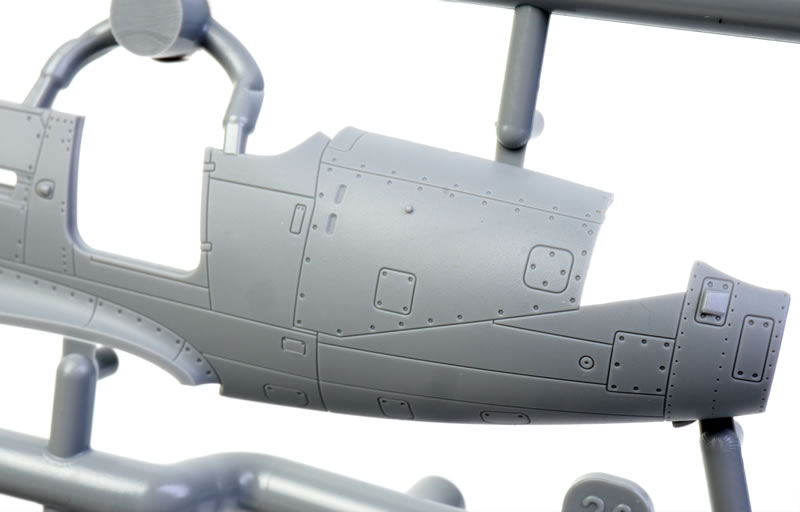
The fuselage is supplied as left and right halves with a few elements that allow some important options.
The most obvious is the forward upper gun cowl panels. Two styles are included with subtle variations.
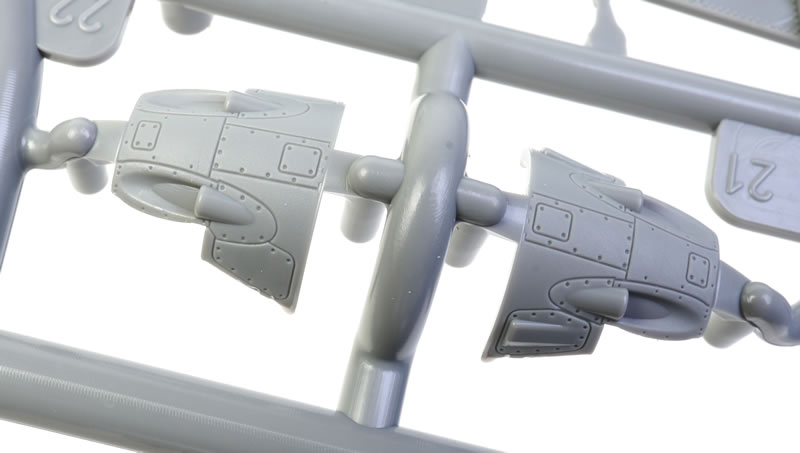
Some cockpit structural detail is moulded directly to the inside of the fuselage halves. Additional separate parts include a plastic cockpit floor, throttle quadrant; instrument panel, a moulded pair of rudder pedals, control column, radios and more.
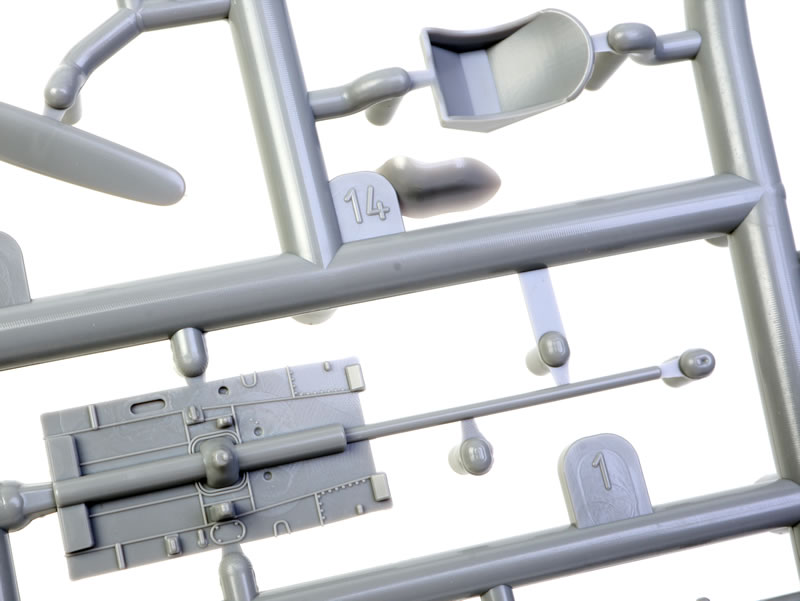
The instrument panel features raised detail that will respond well to careful dry brushing.

As an alternative, an overlay decal is supplied for the instrument panels and switch panel.
Three small chrome metal balls are supplied as nose weight. These are placed into recesses above the front landing gear bay.
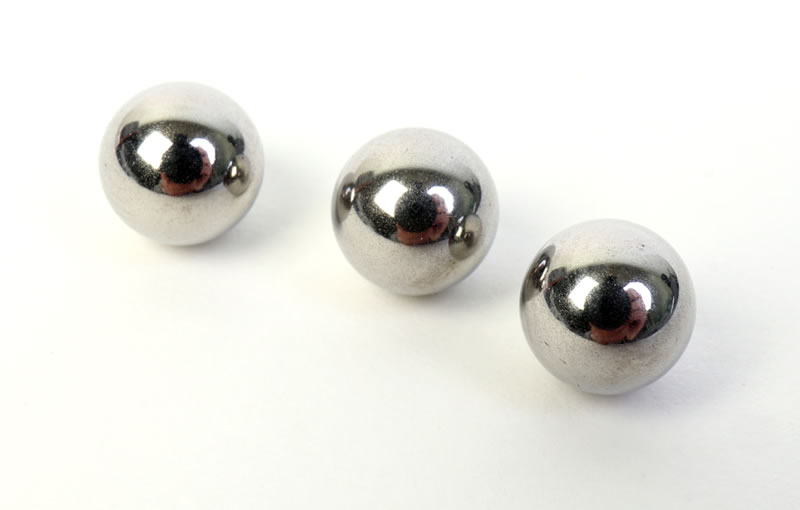
Exhausts are moulded as one-piece per side. The ends are moulded solid - perfectly understandable in this small scale.

The wing parts are full span lower and separate port and starboard halves for the top. They are suitably thin at the trailing edges. Aileron hinge lines are appropriately heavier than the general panel line detailing.
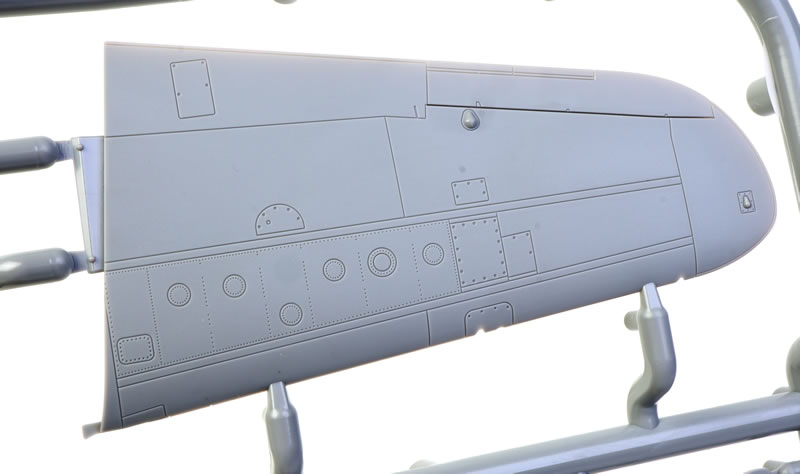
The wheel wells are nicely detailed between the upper wing halves. The are presented as one piece each and feature very fine raised letter on the sidewalls. Tyre tread is smooth. The wheels are subtly bulged and flattened.
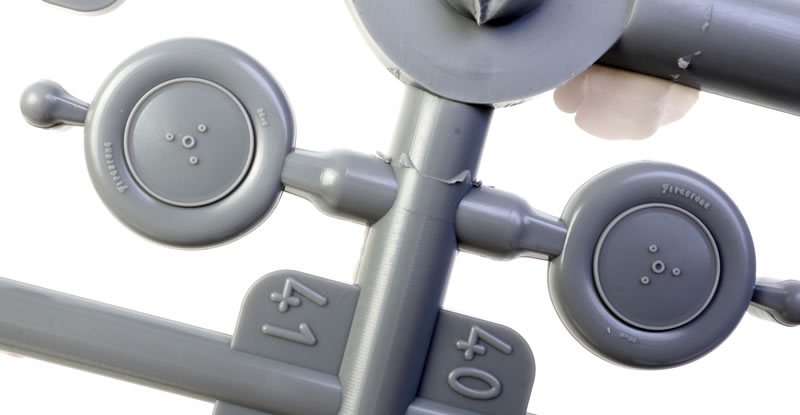
Elevators and rudder are separate parts and may be posed to taste.

The tail wheel and strut are moulded as a single part. Detail looks good.
Ordnance includes two underwing gun pods, a pair of drop tanks, 100 kg bombs and 250 lb bombs.
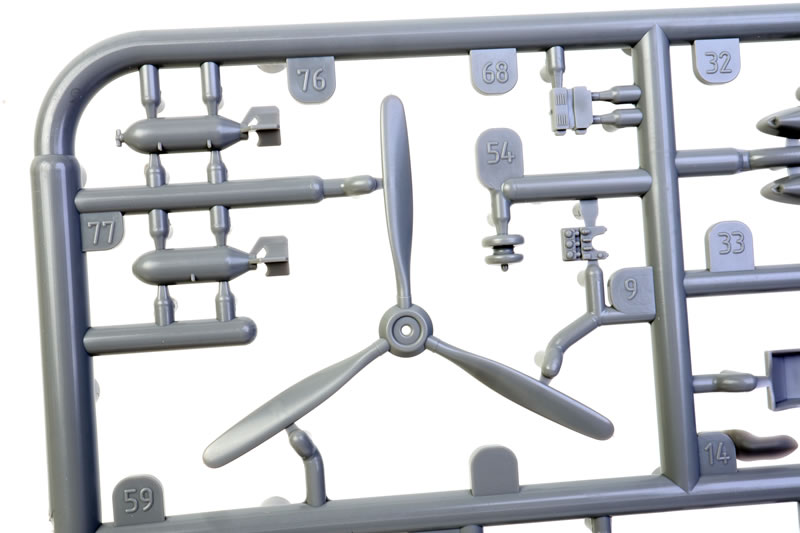
The canopy parts are thin and clear.

The two side doors are moulded as clear parts. They may be posed open or closed. Note that pilot entry and egress was usually from the starboard side. Self-adhesive die-cut masks are supplied for the windows, canopy and wheels. This is a thoughtful and time saving touch.
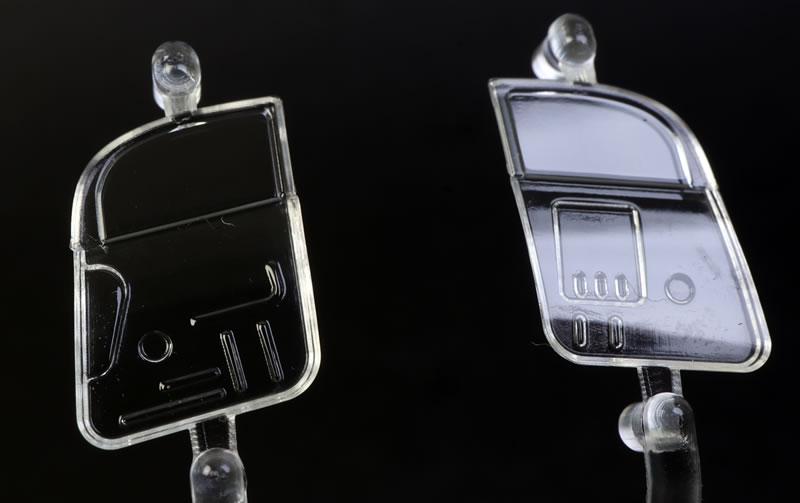
Arma Hobby released their 1/72 scale Expert Series FM-2 Wildcat in March 2020. This was followed by the lower spec and reduced price Model Kit series FM-2 later in 2020.
Arma Hobby's 1/72 scale F4F-4 Wildcat comprises 80 parts in grey plastic, 14 parts on a single photo-etched fret; self-adhesive canopy and wheel masks; markings for five aircraft and bonus markings for another four options.
The grey plastic parts are delivered on two sprues. Moulding quality is excellent with no flaws or visible moulding imperfections on my sample, only a little flash on some of the smaller parts. Arma’s website advises that long-run metal moulds are used for their kit production, and it really does show.
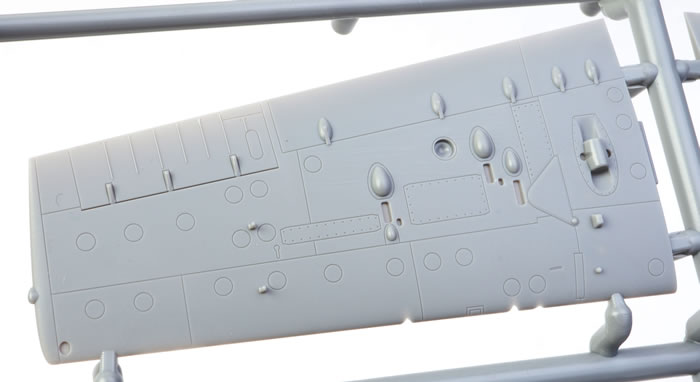
Being a long-run kit, the parts are moulded with all the alignment aids that you would expect including locating pins, holes and tabs.
The larger parts are moulded with a satin finish. Surface textures are just gorgeous. Recessed panel lines, raised fastener heads, blister fairings and other structural details are very fine.
The fabric texture on the rudder, elevators and ailerons are represented by subtly raised rib tapes. The elevators are moulded as a pair so they may be posed to taste. The rudder is a separate part too.
The fuselage is supplied as left and right halves with the standard fin moulded to the fuselage halves.
Some cockpit sidewall detail is moulded directly to the inside of the fuselage. There is also a plastic cockpit floor, front and rear bulkheads, side consoles, a moulded pair of rudder pedals that plug in behind the instrument panel, control column and more.

A plastic instrument panel is also supplied with raised bezels and switches.
Wheel wells are nicely detailed. The intricate landing gear is cleverly moulded in a minimum number of parts, although care will be required during alignment and assembly. Test fit thoroughly!

Two styles of main wheel are offered, as are two different tail wheel parts – covered and uncovered. The main wheels are subtly bulged and flattened.
The engine is very well done. The two rings of cylinders boast fine cooling fin detail. This is supplemented with pushrods and the crankcase cover. Pushrods are supplied as two parts and the exhaust manifold is another part. Seven decals are included for the crankcase and magnetos.
Alternative crankcase and engine cowlings are supplied for the FAA Martlet Mk.II.

The wings are moulded in four parts with upper and lower, port and standard halves. Trailing edges are very thin – almost translucent.
Two drop tanks wrap up the grey plastic parts. Photo-etched bomb racks are included but bombs are not.
The canopy parts are thin and clear and offer separate parts for the windscreen and the sliding section. The gunsight lens is a clear part too.
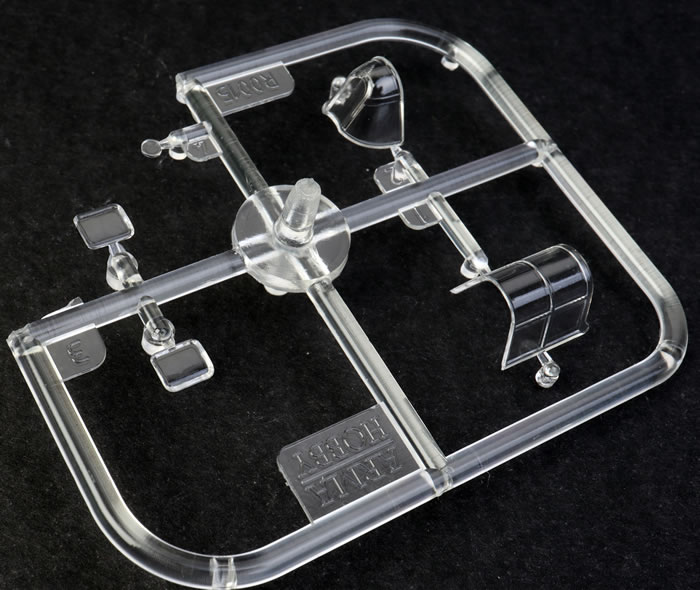
Wing tip navigation lights are moulded as part of the wings.
Self adhesive masks are supplied for the birdcage canopy. This will be welcomed by modellers who dislike cutting their own masks.
Instructions are supplied as a 16 page stapled A5-sized booklet. Some of the assembly sequences are quite complex so make sure you test fit until you are sure where everything goes before you commit to glue (I wish hat I would follow my own advice sometimes...).
Arma Hobby's 1/72 scale P-39 Airacobra and F4F-4 Wildcat are both a gorgeous kits with their crisp surface textures, high moulding quality, thoughtful parts breakdown, useful options and very high level of detail.
Having both kits together in the one box can only be a good thing!
Thanks to Arma Hobby for the sample
Review Text and Images Copyright © 2022 by Brett Green
Page Created 12 January, 2023
Last updated
14 January, 2023
Back to HyperScale Main Page
Back to Reviews Page |
Home
| What's New |
Features |
Gallery |
Reviews |
Reference |
Forum |
Search